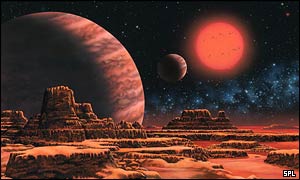

December 5, 2002 - BBC
For the first time, astronomers have obtained an accurate measurement of the mass of a planet circling another star.
The planet is one of a pair that orbit Gliese 876, one of the closest stars to our Sun, and the closest star around which a planet has been found.
By accurately measuring the motion of the parent star across the sky, the astronomers have been able to pinpoint the planet's orbit and hence its mass.
The planet, called simply Gliese 876b, has been found to be about twice as heavy as Jupiter and orbits its star at a distance of about one-fifth of the Earth's distance from our Sun.
Close companion
Although 15 light-years away, Gliese 876 is still one of the closest stars to us. Its planet Gliese 876b was discovered using the Doppler technique that looks for planet-induced motions in the parent star.
The Doppler method cannot determine the exact mass of the planet. It only sets a lower limit on it, and leaves open the possibility that the companion object is something larger than a planet, such as a failed star called a brown dwarf.
The new series of observations were planned and executed by Dr George Benedict of the University of Texas at Austin, US.
By charting the movement of the parent star on the sky, Dr Benedict was able to determine the exact shape of the orbit and precisely calculate the planet's mass.
Gliese 876b is now known to weigh between 1.89 and 2.4 times as much as Jupiter. Previous estimates had put its mass between 1.9 and 100 times that of Jupiter.
Possible moons
"Knowing the mass of extrasolar planets accurately is going to help theorists answer lots of questions about how planets form," Dr Benedict says.
"When we get hundreds of these mass determinations for planets around all types of stars, we're going to see what types of stars form certain types of planets.
"Do big stars form big planets and small stars form small planets?"
The planet circling Gliese 876 is presumably gaseous like Jupiter.
Calculations suggest that it has a surface temperature of minus 75 degrees Celsius. Rocky moons orbiting it are a possibility.
ASTRONOMY ARTICLES ASTRONOMY INDEX CELESTIAL BODIES INDEX PHYSICAL SCIENCES INDEX CRYSTALINKS MAIN PAGE